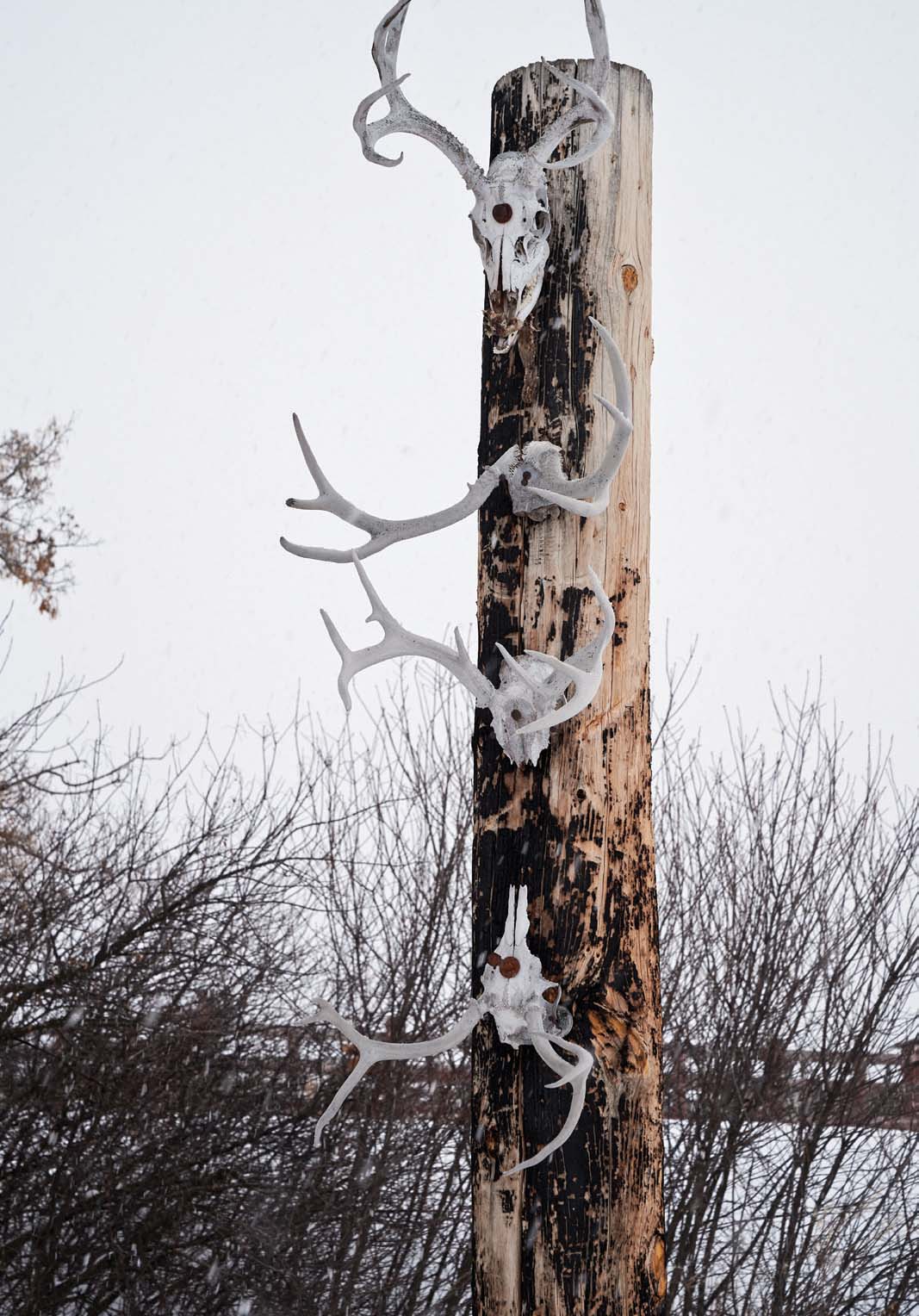
22 Nov LOCAL KNOWLEDGE: RED SPIDER WOMAN
After picking up the rental car, we were jumpy about the bitter weather — an emptiness I could feel in the pit of my stomach. The 115-mile drive from Billings, Montana skirted the Little Bighorn Battlefield National Monument. Then it bisected the Crow Reservation, which borders the Northern Cheyenne Reservation, their onetime mortal enemy and our final destination. Through the frosted windshield, the snow was 3 feet on the level, and the two-lane road (what we could see of it, at least) was snow-packed. The early February conditions degraded under a thick shroud of low, gray clouds. Then, freezing rain turned everything into an otherworldly shade of white. Jim Fergus and I proceeded with caution.
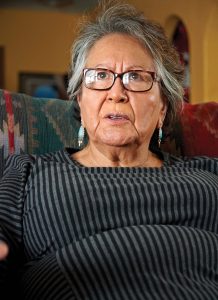
Writer Jim Fergus admitted he sensed magic in the presence of Margaret Behan, the Cheyenne medicine woman also known as Red Spider Woman.
Other than some horses, the only living thing we saw was a lonely, sharp-tailed grouse that fanned its wings and then glided across the roadway. After what felt like forever, we pulled off the highway onto a snow-covered road that snaked along Rosebud Creek, a location made notorious by the Battle of the Rosebud.
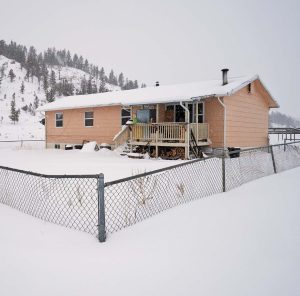
Margaret Behan’s modest rental home along Rosebud Creek was surprisingly cozy on the bitterly cold winter day we visited her in early February.
We arrived at a mocha-colored modular home with a small wooden front porch enclosed within dilapidated anchor fencing. The aroma of pine whirled out of the chimney. Margaret Behan and her 15-year-old blue heeler, Max, greeted us at the door. As we removed our snowy boots and heavy coats, she told us that the word “Cheyenne” derived from the French word for dog, chienne, but “we call ourselves the Morning Star people.”
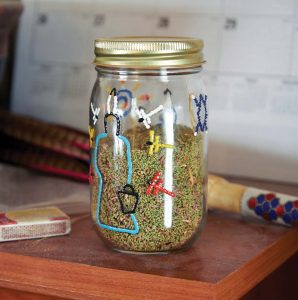
Behan’s hand-decorated jar contains dried cedar foliage, which she burns for ceremonial purposes.
The French magazine America had commissioned Fergus, who’d heard about Behan from friends, to portray a modern-day Indigenous elder. Fergus’ 1999 novel, One Thousand White Women: The Journals of May Dodd, is a historical fictionalized story set on the Northern Cheyenne Reservation. The novel, a bestseller in France, fueled this assignment. Because we are pals and long-time collaborators, he invited me to tag along and take photographs.
Behan founded the Cheyenne Elders Council in 2007. In 2012, she hosted the 11th gathering of the International Council of Thirteen Indigenous Grandmothers, where participants rode wild Nevada mustangs 1,000 miles to commemorate the 1878 Northern Cheyenne Exodus from Oklahoma to Montana, which Little Wolf and Dull Knife led. The two war chiefs depended on North Woman (a medicine woman who is both a relation and inspiration of Behan’s) to guide them back to Montana. In attendance were a great-great-great-grandniece of General George Custer, who apologized to the Northern Cheyenne, and a great-great-granddaughter of Brig. Gen. Anson Mills, who also offered an apology.
Behan, also known as Red Spider Woman, wore a tie-dye dress, and turquoise earrings dangled amidst her short gray hair. Bespeckled, her wide, knowing face was fierce yet kind. Her skin glowed, and she radiated with health.
Wasting no time, Behan led Fergus to the wood stove. She took up her pheasant-tail beaded prayer fan to smudge him with smoke from pinches of dried, burning cedar, and then she turned him to the four directions to bless and purify. Speaking what I assumed were prayers in her native tongue, Behan opened his hands, palms out, and, after fanning him, placed her hand upon his heart.
She didn’t make a big deal out of it, but she was cleansing his energy. Whatever Behan sensed as she worked her medicine — another word for spirit — she kept to herself. We sat on a kilim sofa as she made a pot of chamomile tea. Fergus pulled out his writing pad and put his phone on record. As snow pelted the windows, his questions and her replies lasted much of the day.
As a child, Behan recalled sitting with her siblings in a circle with her grandparents. Her grandfather or grandmother would single out each child and make observations and comments: “‘You have such a beautiful smile’ or ‘Your eyes look just like your mother’s.’ They refrained from making judgments or criticisms; instead, they expressed only loving words, which must have established a platform of confidence for the children.”
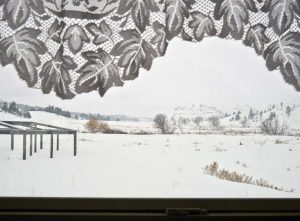
Behan’s kitchen window frames Deer Medicine Rocks to the north.
When she was a young girl, her family lived in western Colorado, first in Towaoc and later in Ignacio, where her father worked as a Bureau of Indian Affairs police officer on the Mountain Ute Reservation. Mesa Verde was a place she loved. Behan later married a member of the Cochiti Pueblo in New Mexico.
Behan’s story — a tale of survival, perseverance, and redemption — resembles a line graph, with few highs plotted against a series of seismic lows. Her husband abused her, which included physical assault, rape, and attempted murder when he drove into her with his truck. However, he wasn’t the only problem. Behan also struggled with addiction and, at a young age, became a whiskey-drinking alcoholic. “I drank to fit in,” she said. To compound matters, when her husband drank, he became vicious. Behan divorced him after the birth of their third child.
On the rebound, Behan remarried “a gentle soul” who lived in the San Juan Pueblo near Chimayo, New Mexico. He was good to her, but not long after they married she discovered his hidden addiction: heroin. Recognizing he wasn’t ready to face his addiction and scarred by the abuse of her first marriage, Behan fled to Taos, seeking the safety of her grown daughter’s trailer. Things would get worse before they got better.
Listening to stories of such cruelty, self-hatred, and abuse dismayed me. When she paused, I excused myself, stepping out on her snowy back porch and gazing past a red loafing shed and pole corral. Pine-clad bluffs rose above the creek bottom. There was a vague hum to the silence. I had friends at the Taos Pueblo and had spent time on reservations in the Dakotas, Arizona, and New Mexico, but nothing prepared me for the travails of Behan’s life. And it was likely that such trials and tribulations were far too common across America’s Native American reservations. Behan’s life story made me feel heartsick.
After completing a treatment program, Behan began a journey of self-discovery, reclaiming not only her sobriety, but her very soul. She went back to school, where she studied psychology, and eventually became a substance abuse counselor. Along with her traditional teachings, she has led retreats for children and codependents of alcoholics. According to Behan, “Abuse and addiction are simply forms of self-hatred. Addiction is an energetic void whereby self-medication is a futile attempt to fill the unfillable.”
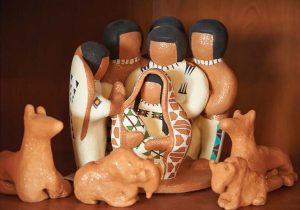
Behan’s Pueblo-style clay figurines — sold at the Custer Battlefield Trading Post — reveal her penchant for artistry in all forms.
But Behan had always envisioned herself as an artist. In New Mexico, she learned to work the local clay into figurines of Native people and animals, eventually winning awards. She sought additional outlets, studying creative writing and later learning the art of traditional beadwork.
While on the Pueblo, Behan learned the art of New Mexican cuisine, making posole, handmade tortillas, and more. She displayed her culinary talent for us, serving roast-chicken burritos with green chile, garnished with lettuce, tomatoes, cucumber, onions, and sour cream, which we enjoyed for lunch. “Cooking is the center of everything,” she said.

We watched Behan prepare flour tortillas from scratch for our roast-chicken burritos.
Standing at her kitchen window, where white lace garlanded the windows, Behan casually mentioned that beyond the pine-clad hill was the place — Deer Medicine Rocks — where Sitting Bull had his vision: He saw many soldiers, “as thick as grasshoppers,” falling upside down into the Lakota camp, which his people interpreted as a foreshadowing of a major victory. “I talk to Sitting Bull all the time,” she said with a mischievous glint in her eye.
I couldn’t refrain from asking, “Does he talk back?”
“Oh, yes, but I only see orbs or flashes of light, but it’s enough to reveal his presence,” she said as she made short chopping gestures like sign language. “I’ve been praying to him today to help keep you safe on your journey here.”
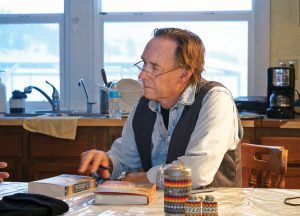
Fergus interviewed Behan in her kitchen after she prepared us lunch, fulfilling a French magazine’s commission to profile a modern Indigenous elder.
After lunch, the conversation turned to reservation life. Behan spoke candidly about issues that continue to plague her people: colonization and racial trauma. She wasn’t exactly contemptuous of patriarchy on the reservation but shared a statistic that 98 percent of the workforce on the rez were women. “The women hold jobs while the men, defeated and lacking purpose, watch television,” she opined.
Behan seemed to float above the petty politics that appeared to govern thinking on the reservation. Her presence intimidated and made some people mistrust her. As a woman, she seemed impervious to the male tendencies to fix, save, control.
“People today have an addiction to drama,” Behan continued. “When there isn’t any, they manufacture it. No one seems to see the value of simply being. That’s what I do. I don’t tell anyone what to do. I’m not comfortable being perceived as anything special. I am just a woman, Red Spider Woman, who doesn’t need anyone, including a man, to tell me who or what I am. I am simply on a journey of self-discovery in this beautiful world. People don’t see how beautiful all of it is, both what we call good and what we call bad. It’s all beautiful if only people could move beyond their limited belief systems.”
Her lack of vanity struck me. She was at home in her very skin — no pretense, nor any vestige of self-importance. She was similar to the shamans I’ve encountered in Mexico and Peru. There is an ancient definition of a shaman: the wounded healer. Behan, once she had healed, redefined her dreams — choosing to be in service and heal others. She alluded to the concept of the soul, where time becomes irrelevant. “Our very lives are a tremendous gift, but many of us become lost in our insecurities, suffering, and confusion,” she said. “We often lose sight of this reality.”
Fergus concluded the first interview and made plans to return the following morning. In the dusky blue light, I lost sight of our tire tracks and buried the rental in a snowbank. It must have struck Behan as comical, these two Anglo city folk stuck in her driveway. After shoveling to little effect for 30 minutes, Behan advised us to jam a nylon tarp under the rear wheels. Fergus reversed the Tahoe, freeing the vehicle. In the glare of his headlights, I walked ahead like a signaling highway flagger, keeping him on track. Working in tandem, he drove through the ice-crusted snow to the safety of the plowed road a mile away. Was our becoming stuck a metaphor?
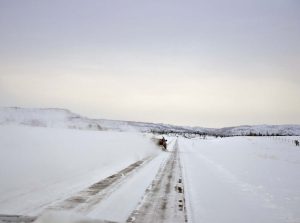
Motoring through the Northern Cheyenne Reservation in the dead of winter is a marriage of weather-induced anxiety and nearly unmitigated solitude.
Back at Behan’s the following morning, Fergus’ interview continued.
“When I was a child, my grandfather asked me what I wanted from this world. And I told him I wanted to travel, to see the world. As one of the 13 grandmothers, I got this opportunity,” she said. “And what my travels revealed, after spending time with the Indigenous community around the globe, was that their spiritual worldview was like our Cheyenne beliefs and traditions. There is a synchronicity, something universal in spirituality the world over.”
Fergus asked her opinion about the future of her people.
“It may take seven generations to heal the wounds of the people,” she said. “That alcohol and drugs are rampant comes as no surprise. Punishment for this kind of ‘acting out’ isn’t the way to deal with these issues. This is a racial trauma, a psychic wound to my people. At this time, the tribal councils lack leadership. The men are distrustful. They have trouble electing a tribal leader.”
“I work to promote peace between the Crows and the Cheyennes, as well as between the Northern and Southern Cheyennes and the Arapaho,” she added. “We have the same blood, the same genealogy, and our separation is the consequence of colonialism. Today, we no longer get along. I try to bring the branches together, unlike the Western world, but with a natural, Indigenous innocence.”
Driving here from Billings, Fergus had hinted that something mysterious had guided him to this wayward place. But he’d dispelled it. Being in Behan’s presence felt more like a teaching opportunity than an interview or a photo shoot. Fergus brought copies of his books as gifts. “If you read them,” he told her, “you will point out all the mistakes I make about your people.”
“Look at me,” she beseeched, as she touched his novels about her people. “I have something to say.”
Her reaction surprised him. She was skeptical about how a white man could have written about not only women but also the Cheyenne. I watched in disbelief as a Northern Cheyenne medicine woman cracked my friend wide open. Fergus wrote her response in his article:
She turns the books over and goes through the presentation texts. Then she carefully slides them onto the table in front of her and places her hand on the cover of One Thousand White Women, as gently as, during her daily blessing, she placed it on my heart. “You have no reason to apologize. You wrote these books; it is your work and that of no one else. This certainly represents very hard and very long work.”
Her words pierced my heart. Something karmic had taken place — perhaps a reparation, but neither of us could understand the deeper implications. Though I lacked perspective, it was as if the past merged into the present — laid bare by the emotion of her words. Her benediction shifted us both.
After all the vicissitudes of her tangled life — a life of pain, suffering, poverty, and addiction — Behan spoke about finally “getting it.” Her face revealed no bitterness, no grief. It was the face of Indigenous America, victimized by unimaginable nightmares, devastation, bigotry, and genocide. But there wasn’t the least bit of self-pity.
Throughout her life, Behan rose from the ashes like a phoenix and came to understand herself and her timeline. In the course of this, her concepts of time transformed, whereby she recognized her soul as a non-linear, fluid spirit, moving through time like the symbol of a Medicine Wheel.
What is certainly true is that Behan is a medicine woman. Over my desk hangs her portrait. Her gaze could shatter glass. It’s a symbol and a reminder of Sitting Bull’s vision of Native wisdom’s rebirth.
Stephen Collector is a long-time professional photographer and writer. His writing has been featured in The Drake, The Pointing Dog Journal, Big Sky Journal, Anglers Journal, and The Quail Forever Journal. His books include Law of the Range: Portraits of Old-Time Brand Inspectors and Journeys to Ancient America. His photography has illustrated many national magazines and his fine art photography has been widely exhibited. He resides in Boulder, Colorado; stephencollector.com.




No Comments